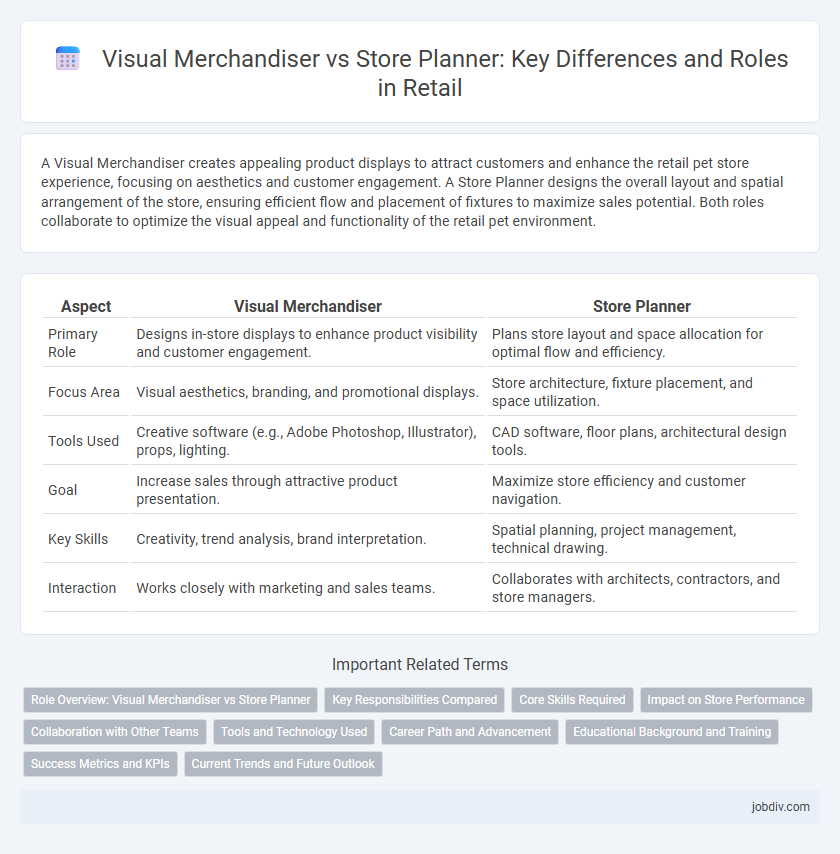A Visual Merchandiser creates appealing product displays to attract customers and enhance the retail pet store experience, focusing on aesthetics and customer engagement. A Store Planner designs the overall layout and spatial arrangement of the store, ensuring efficient flow and placement of fixtures to maximize sales potential. Both roles collaborate to optimize the visual appeal and functionality of the retail pet environment.
Table of Comparison
| Aspect | Visual Merchandiser | Store Planner |
|---|---|---|
| Primary Role | Designs in-store displays to enhance product visibility and customer engagement. | Plans store layout and space allocation for optimal flow and efficiency. |
| Focus Area | Visual aesthetics, branding, and promotional displays. | Store architecture, fixture placement, and space utilization. |
| Tools Used | Creative software (e.g., Adobe Photoshop, Illustrator), props, lighting. | CAD software, floor plans, architectural design tools. |
| Goal | Increase sales through attractive product presentation. | Maximize store efficiency and customer navigation. |
| Key Skills | Creativity, trend analysis, brand interpretation. | Spatial planning, project management, technical drawing. |
| Interaction | Works closely with marketing and sales teams. | Collaborates with architects, contractors, and store managers. |
Role Overview: Visual Merchandiser vs Store Planner
Visual Merchandisers focus on creating appealing and strategic product displays that attract customers and enhance the shopping experience, using principles of color, lighting, and layout design. Store Planners are responsible for designing the overall store layout, optimizing space utilization, traffic flow, and fixture placement to maximize sales and operational efficiency. While Visual Merchandisers emphasize aesthetic presentation and brand storytelling, Store Planners concentrate on logistical planning and functional store design.
Key Responsibilities Compared
Visual Merchandisers focus on designing and implementing attractive product displays to enhance customer engagement and drive sales, emphasizing aesthetic appeal and brand storytelling. Store Planners concentrate on the spatial layout and coordination of store fixtures, ensuring optimal traffic flow and efficient use of retail space to maximize operational effectiveness. Both roles collaborate to balance creative presentation with functional store design, directly impacting the overall shopping experience and sales performance.
Core Skills Required
Visual Merchandisers excel in creativity, spatial awareness, and understanding consumer psychology to design appealing product displays that boost sales. Store Planners require strong analytical skills, knowledge of architectural layouts, and proficiency in space optimization to efficiently plan store layouts and inventory placement. Both roles demand excellent collaboration and attention to detail to enhance customer experience and drive retail performance.
Impact on Store Performance
Visual Merchandisers directly influence store performance by crafting compelling product displays that drive customer engagement and increase sales conversions. Store Planners optimize store layout and space utilization, enhancing traffic flow and overall shopping experience to maximize revenue per square foot. Both roles are integral in boosting operational efficiency and elevating the retail environment's appeal.
Collaboration with Other Teams
Visual Merchandisers collaborate closely with marketing and sales teams to design eye-catching product displays that boost customer engagement and drive sales. Store Planners work extensively with architects, construction crews, and supply chain managers to optimize store layouts and ensure efficient space utilization. Their teamwork ensures cohesive brand representation and seamless in-store customer experiences.
Tools and Technology Used
Visual Merchandisers rely heavily on design software such as Adobe Creative Suite and 3D modeling tools like SketchUp to create eye-catching displays that enhance customer engagement. Store Planners utilize specialized CAD software and space management platforms like AutoCAD and Revit to optimize store layouts for efficient traffic flow and product placement. Both roles integrate data analytics tools to assess visual impact and sales performance, ensuring retail environments maximize profitability and customer experience.
Career Path and Advancement
Visual Merchandisers focus on creating appealing product displays and in-store layouts to enhance customer experience, while Store Planners specialize in the architectural and spatial design of retail stores. Career advancement for Visual Merchandisers often progresses toward roles in creative direction or brand management, emphasizing artistic and marketing skills. Store Planners typically move into senior roles involving project management or retail development, requiring a strong background in design, engineering, and logistics.
Educational Background and Training
Visual Merchandisers typically hold degrees in fashion design, marketing, or fine arts, emphasizing creative skills and aesthetics through specialized courses in color theory, display techniques, and consumer psychology. Store Planners often have educational backgrounds in architecture, interior design, or retail management, focusing on spatial planning, CAD software proficiency, and logistics to optimize store layout and customer flow. Both roles benefit from internships and certifications in retail operations and brand management to enhance practical knowledge and industry relevance.
Success Metrics and KPIs
Visual Merchandisers drive sales through compelling product displays, focusing on KPIs such as sales conversion rates, average transaction value, and customer dwell time. Store Planners optimize store layouts and space utilization, measuring success by metrics like foot traffic patterns, space productivity per square foot, and inventory turnover rates. Both roles contribute to revenue growth by aligning visual appeal and operational efficiency with consumer behavior analytics.
Current Trends and Future Outlook
Visual Merchandisers increasingly leverage augmented reality (AR) and interactive displays to enhance customer engagement and drive in-store sales, reflecting a trend toward immersive shopping experiences. Store Planners focus on data-driven layout optimization, incorporating AI analytics and sustainable design principles to maximize space efficiency and minimize environmental impact. Future outlooks show a convergence of these roles, integrating technology and sustainability to create adaptive, customer-centric retail environments.
Visual Merchandiser vs Store Planner Infographic

 jobdiv.com
jobdiv.com